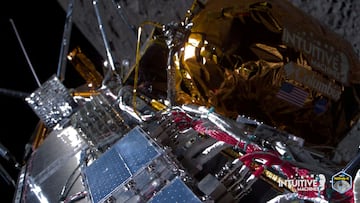The Odysseus lands on the Moon: What is the mission of the lunar lander?
The US has landed its first spacecraft on the Moon in over five decades, which will help pave the way for planned manned missions in the near future.

It took Odysseus some twenty years to return to his home in Ithica, much less than the more than five decades it has taken the United States to return to the Moon. On 22 February 2024, Intuitive Machines’ IM-1 mission named after the mythical Greek hero successfully landed on our celestial neighbor.
This latest endeavor is more than just putting a spacecraft on the lunar surface. NASA is working with private American companies through its Commercial Lunar Payload Services (CLPS) initiative under the Artemis program which includes the IM-1 mission that “is part of a broader strategy to foster a sustainable presence on the Moon.”
The contracted companies will deliver payloads to the Moon that will “perform science experiments, test technologies, and demonstrate capabilities to help NASA explore the Moon as it prepares for human missions.” Currently, the US space agency is aiming to have its first crewed mission land on the lunar surface in 2026.
The Odysseus lands on the Moon: What is the mission of the lunar lander?
“At the heart of the IM-1 mission is the Nova-C lunar lander,” explains Intuitive Machines. This state-of-the-art technology includes an environmentally friendly propulsion system powered by a mix of liquid oxygen and liquid methane.
The mission’s primary objective was to safely deliver a variety of payloads to the Moon’s south pole region, specifically, near Malapert A, an impact crater. Until now this part of the lunar surface has not been explored but is of broad interest as it may have stores of water in the form of ice in its shadowy craters. This could be converted into water for drinking or even rocket fuel.
Odysseus payload carried both commercial cargo and NASA instruments
On board Odysseus or “Odie,” is a mix of commercial cargo and six NASA science instruments. One of these, NASA’s experimental Navigation Doppler Lidar (or NDL) technology had to take over as the primary navigation sensors for Odie’s landing after the lander’s own system malfunctioned.
The space agency’s instruments on Odysseus “will focus on demonstrating communication, navigation and precision landing technologies, and gathering scientific data about rocket plume and lunar surface interactions, as well as space weather and lunar surface interactions affecting radio astronomy,” according to NASA.
Also on board is an insulation material developed by Columbia Sportswear, Omni-Heat Infinity, to shield IM-1 for the extreme temperatures of outer space that will be put to the test within a week. Once the lunar night falls upon the Moon’s south pole the craft will be subjected to two weeks of harsh temperatures of -208ºF.
Additional devices Odie carried to the Moon include the EagleCam developed by students at Embry-Riddle Aeronautical University which will take a selfie of the lander. It will also test an electrostatic dust-removal system that could lead to future advances in spacesuit technology.
A sculpture designed in consultation with artist Jeff Koons called Moon Phases was on Odysseus too. The “symbol of human curiosity and the desire to achieve” is comprised of 125 unique artworks, each consisting of 3 components, one to stay on the Moon in a cube, one on Earth and an NFT.
Odie has aboard a precursor to the ILOA Hawai’i flagship Moon South Pole Observatory ILO-1 called ILO-X. The device includes a miniaturized dual-camera lunar imaging suite which aims to capture some of the first images of the Milky Way Galaxy Center from the surface of the Moon and perform other celestial astronomy.






